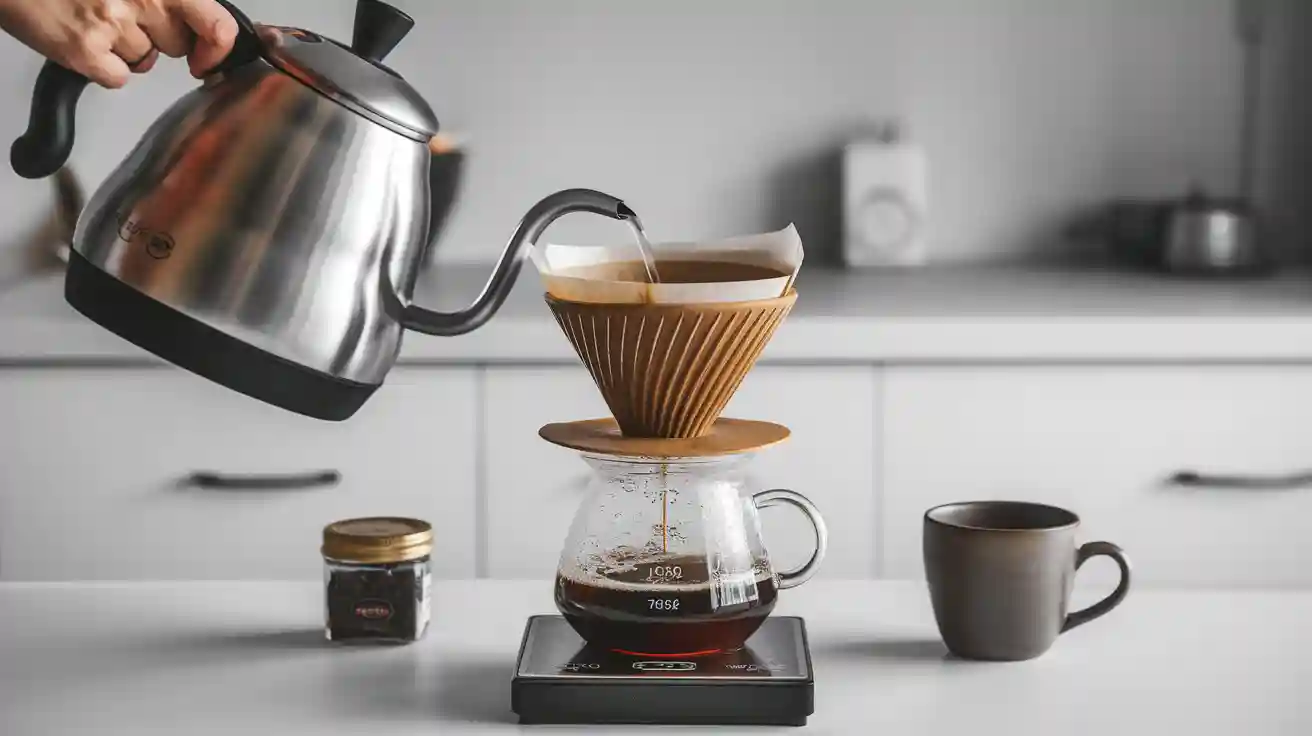
You improve your brewing experience when you use a gooseneck electric kettle. This kettle gives you precision pouring and temperature control, which help you reach perfect brewing. Gooseneck kettle design lets coffee lovers and tea enthusiasts saturate grounds evenly and extract maximum flavor. You unlock better quality with an electric coffee kettle.
- Gooseneck kettle spouts allow slow, steady, and accurate pouring for optimal extraction.
Gooseneck Electric Kettle: What Makes It Unique
Precision Pouring Spout Design
When you use a gooseneck kettle, you notice the difference right away. The spout stands out with its long, narrow, and curved shape. This design gives you precision pouring, which means you can control the flow and direction of water with ease. You avoid splashing and uneven saturation. The spout lets you pour slowly and steadily, which is important for brewing methods like pour-over coffee. You can use special techniques, such as spiral or bloom pours, to get even extraction and balanced flavor.
Tip: A gooseneck kettle’s spout helps you avoid over-extraction or under-extraction, so every cup tastes just right.
Here’s how gooseneck electric kettles compare to traditional kettles:
| Design Feature | Gooseneck Electric Kettles | Traditional Kettles |
|---|---|---|
| Spout Design | Long, narrow, curved spout for precise control | Wide spout, fast and uncontrolled flow |
| Pouring Control | Slow, steady, accurate pouring for even saturation | Limited control, uneven extraction |
| Temperature Control | Adjustable settings and digital displays | Usually no temperature control |
| Ergonomics | Counterbalanced handles, lightweight | Basic handle, less comfort |
| Brewing Impact | Supports delicate brewing, consistent results | Less suitable for precision brewing |
Ergonomic Features for Controlled Brewing
A high-quality electric kettle gives you more than just a good spout. You get ergonomic handles that fit your hand and reduce wrist strain. Many gooseneck kettles have lightweight bodies, so you can pour with excellent control. Some models offer a 360° cordless base, making it easy to pick up and set down the kettle from any angle. You also find user-friendly temperature controls and digital displays, which help you set the perfect temperature for your brew. With these features, you enjoy smooth water flow and repeatable results every time you use your gooseneck electric kettle.
Electric Coffee Kettle Benefits for Perfect Brewing
Variable Temperature Control
You gain a major advantage with variable temperature control in an electric coffee kettle. This feature lets you set the exact water temperature for your brew. Coffee lovers know that different beans and tea leaves need different temperatures. For example, green tea tastes best at 175°F, while coffee often needs water close to 200°F. If the water is too hot, you risk burning delicate grounds or leaves. If it is too cool, you miss out on full flavor extraction. Modern kettles with digital displays make it easy to choose and hold the right temperature. You get repeatable results every time.
Tip: Use the preset temperature options for different brewing styles. This helps you avoid over-extraction or under-extraction and keeps your drinks tasting great.
Here are some key benefits of variable temperature control:
- You set and maintain precise water temperatures for each brewing method.
- You protect flavor by avoiding water that is too hot or too cold.
- You use hold temperature functions to keep water steady during brewing.
- You enjoy ultimate precision with adjustable increments.
- You can select presets for pour-over coffee or green tea.
Consistent Heating and Extraction
Consistent heating is essential for perfect extraction. When you use an electric coffee kettle, you get fast heat time and quick heating. This means you spend less time waiting and more time enjoying your drink. Fast boiling also helps you brew more efficiently. Food science experts explain that hot water speeds up chemical reactions during brewing. This process releases aroma compounds and transforms flavors, giving you a richer cup. Cold water extracts flavors slowly and leaves a simpler taste. With consistent heating, you get better extraction and more complete flavor in every cup. Coffee lovers appreciate how an electric coffee kettle makes this process easy and reliable.
- Electric kettles boil water faster than stovetop models, often in just a few minutes.
- They use energy more efficiently and include safety features like automatic shut-off.
Precision Pouring Techniques for Gooseneck Kettle
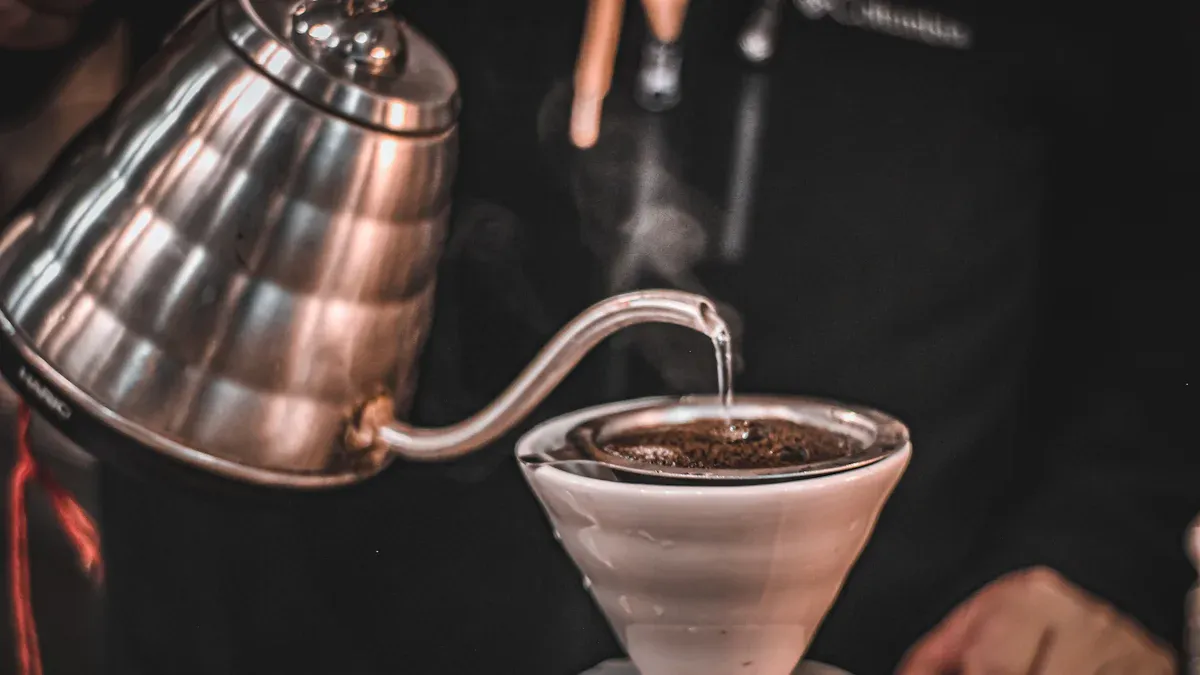
Mastering precision pouring with a gooseneck kettle transforms your brewing experience. You gain control over every drop, which leads to better extraction and flavor. The following techniques help you achieve pour-over perfection and consistent results with every cup.
Slow and Steady Pour Method
A slow and steady pour is the foundation of great pour-over coffee. When you use a gooseneck kettle, you can control the flow of water with ease. This method ensures that water moves evenly over the coffee grounds. You avoid rushing, which prevents under-extraction and over-extraction. Even saturation leads to balanced flavor in your cup.
- A slow pour keeps the brew time within the ideal range of 2.5 to 3 minutes.
- You support the bloom phase by gently saturating the grounds, which releases carbon dioxide and unlocks full flavor.
- The gooseneck kettle’s spout allows you to maintain a thin, steady stream, avoiding agitation that can cause uneven extraction.
Tip: Practice pouring 100 grams of water in 10 seconds through an empty dripper. This helps you develop a feel for the right flow rate and improves your precision pouring skills.
Circular Motion for Even Saturation
Using a circular motion when you pour water is key to even saturation. Start pouring from the center of the coffee bed and move outward in a spiral. Then, return to the center. This technique ensures that all the grounds receive water at the same rate.
A gentle, circular pour helps you avoid dry spots and over-saturated areas. Uniform saturation means you extract flavors evenly, which gives your coffee a balanced taste. The gooseneck kettle makes it easy to control the direction and speed of your pour, which is important for pour-over methods.
Note: Pouring in a clockwise direction is a good starting point, but you can adjust based on your comfort and the results you want.
Adjusting Pour Speed and Height
You can fine-tune your brew by adjusting the speed and height of your pour. Pouring from a higher position, about 8 to 10 inches above the grounds, increases agitation. This can lead to stronger flavors because it boosts extraction. Pouring from a lower height reduces agitation and creates a milder cup.
- Faster pours build a taller water column in the dripper, which shortens brew time and can reduce extraction.
- Slower pours keep the water column low, extend brew time, and increase extraction for a richer flavor.
- The number of pours also affects extraction. More pours mean longer contact time, which can enhance flavor but may require you to adjust temperature and taste.
Callout: Small changes in your pouring technique can make a big difference in the final flavor. Use your free hand for balance, such as holding a towel under the kettle, to improve control and comfort.
The gooseneck kettle gives you the tools for precision pouring. You can monitor water levels, adjust your grip, and make small tweaks to your technique. These adjustments help you achieve consistent results and unlock the full potential of your coffee beans.
| Pouring Technique | Effect on Extraction and Flavor |
|---|---|
| Slow and Steady | Even saturation, balanced flavor |
| Circular Motion | Uniform extraction, no dry spots |
| Adjusting Speed & Height | Control over strength and brew time |
With practice and attention to detail, you can master these techniques and enjoy the benefits of a gooseneck kettle. You will notice improvements in every cup, whether you use pour-over coffee or other pour-over methods.
Achieving Perfect Brewing with Temperature Accuracy
Precision temperature control is the secret to unlocking the best flavors in your cup. When you use a gooseneck electric kettle, you gain the ability to set and hold the exact temperature you need. This level of temperature control helps you avoid common mistakes like over-extraction or under-extraction. You get to enjoy coffee and tea that taste just right, every time.
Setting Optimal Temperature for Coffee
You might wonder why temperature matters so much for coffee. The answer lies in how water extracts flavors from coffee grounds. If the water is too hot, your coffee can taste bitter and harsh. If it is too cool, you get a weak or sour cup. The ideal brewing temperature for most coffee falls between 195°F and 205°F (90°C to 96°C). This range allows you to extract the right balance of oils, acids, and sugars.
Different types of coffee beans and brewing methods need different temperatures. For example, light roasts and single-origin beans often need higher temperatures to bring out their bright and complex flavors. Dark roasts do better with slightly cooler water to avoid bitterness. You can use the table below to guide your customizable brewing process:
| Coffee Bean Type / Roast | Ideal Brewing Temperature (°C) | Ideal Brewing Temperature (°F) | Notes on Flavor and Extraction |
|---|---|---|---|
| Dark Roast | 85 – 90 | 185 – 195 | Lower temp to avoid bitterness, smooths intense notes |
| Single-Origin | 90 – 96 | 195 – 205 | Higher temp for fruity/floral; lower for earthy flavors |
| Arabica | 90 – 96 | 195 – 205 | Higher temp to extract nuanced, delicate flavors |
| Robusta | 88 – 93 | 190 – 200 | Slightly lower temp to tame bitterness, retain body |
| Blended Coffee | 88 – 93 | 190 – 200 | Medium temp to balance flavors from different beans |
| Light Roasts (general) | 90 – 96 | 195 – 205 | Enhances brightness and complexity |
| Dark Roasts (general) | 85 – 90 | 185 – 195 | Avoids excessive bitterness, brings out smooth notes |
You can also see the temperature ranges for different brewing methods in this chart:
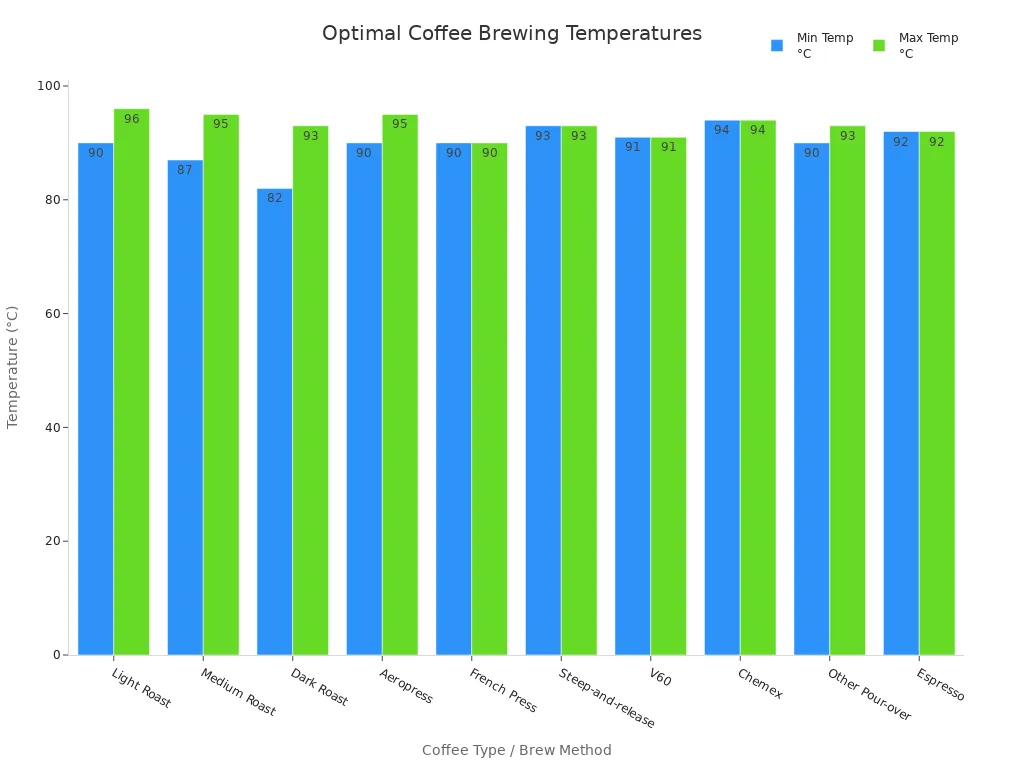
When you use a gooseneck electric kettle with temperature control, you can match the water temperature to your beans and method. This level of customization helps you get the most out of every cup. You avoid the risk of burning delicate grounds or missing out on complex flavors. You also make your brewing process repeatable, which means you get the same great taste every time.
Tip: If you use a coarser grind, try a slightly higher temperature. If you use a finer grind, lower the temperature a bit to prevent over-extraction.
Ideal Temperature for Tea Infusion
Tea enthusiasts know that water temperature can make or break a cup of tea. Each type of tea leaf needs its own temperature to bring out the best aroma and taste. If you use water that is too hot, delicate teas like green or white can turn bitter. If the water is too cool, your tea may taste flat or weak.
Here is a table to help you find the right temperature for each type of tea:
| Tea Type | Water Temperature (°F) | Steep Time (minutes) |
|---|---|---|
| Black Tea | 212 (full boil) | 3-5 |
| Green Tea | 175-180 | 1-2 |
| White Tea | 175-180 | 2-3 |
| Oolong Tea | 195 | 2-3 |
| Pu-erh Tea | 212 | 5 |
| Herbal Tea | 212 | 5-10 |
| Rooibos | 212 | 5-10 |
You can also view the ideal temperature ranges for different teas in this chart:
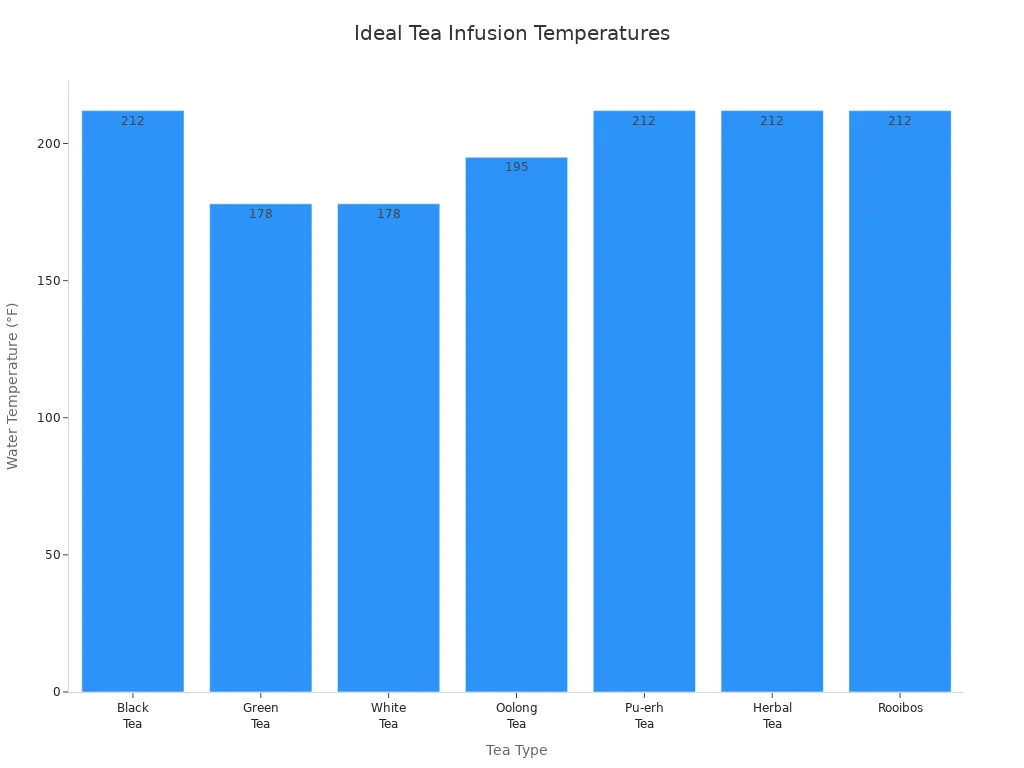
Tea enthusiasts often experiment with temperature control to find their favorite flavor. For green and white teas, keep the water between 175°F and 180°F. This range preserves delicate aromas and prevents bitterness. Black, herbal, and rooibos teas do best with water at a full boil, around 212°F. Oolong teas fall in the middle, usually around 195°F.
Note: Start with the recommended temperature, then adjust by a few degrees to suit your taste. This approach gives you more control and lets you discover new flavors.
Customizable brewing is easy when you use a kettle with precise temperature settings. You can try different temperatures for each tea type and find the perfect balance. This level of customization makes your tea experience more enjoyable and helps you avoid common mistakes.
With the right temperature control, you unlock the full potential of your coffee and tea. You get to enjoy every cup at its best, whether you are a coffee lover or a tea enthusiast.
Consistency in Every Cup with Gooseneck Electric Kettle
Repeatable Brewing Results
You want every cup to taste just as good as the last. A gooseneck kettle helps you reach this goal by giving you control over every step of your brewing experience. Digital temperature controls let you heat water to the exact degree you need. This means you use the same temperature every time, which is important for consistent results. The gooseneck kettle’s spout lets you pour water slowly and steadily. You can use a circular motion to make sure all the coffee grounds get wet evenly. The ergonomic handle and balanced weight make it easy to keep your hand steady, so you can repeat your pouring technique with each brew.
Here are some ways a gooseneck kettle supports repeatable results:
- Set and hold the exact water temperature for every brew.
- Pour water in a slow, steady stream for even extraction.
- Use a circular motion to avoid dry spots in the coffee bed.
- Keep water warm between brews with the “keep warm” feature.
- Enjoy comfortable pouring with an ergonomic handle.
You can also adjust your pour height and rate to match your coffee grind. This level of control makes your brewing experience more predictable and enjoyable.
Avoiding Common Extraction Mistakes
Even with the best tools, mistakes can happen. You can avoid most problems by paying attention to a few key details. The grind size matters a lot. If your coffee is too coarse, your drink will taste weak and sour. If it is too fine, you might get a bitter cup. Always use a consistent grind for your gooseneck kettle.
Water temperature is another important factor. Aim for water between 90°C and 96°C. Too hot, and your coffee will taste burnt. Too cold, and it will taste flat. Use a scale to measure your coffee and water. The ideal ratio is about 1:16 for pour-over.
Pouring technique also affects your brewing experience. Pour slowly and evenly, starting with a bloom phase. This helps release gas from the coffee and leads to better extraction. Try to avoid pouring directly on the filter edges.
Here is a table to help you spot and fix common mistakes:
| Mistake | Effect on Coffee | How to Fix |
|---|---|---|
| Wrong Water Temperature | Bitter or sour taste | Use 90–96°C water; let boiled water rest briefly |
| Bad Coffee-to-Water Ratio | Weak or overpowering flavor | Measure with a scale; use 1:16 ratio |
| Poor Pouring Technique | Uneven extraction | Pour slowly, use circular motion |
| Skipping Bloom | Sour, uneven flavor | Wet grounds, wait 30–45 seconds before pouring |
| Inconsistent Grind | Imbalanced brew | Use a quality grinder for even size |
| Dirty Equipment | Rancid, bitter taste | Clean kettle and grinder regularly |
By following these tips, you can make every brewing experience with your gooseneck kettle smooth and satisfying.
Tips for Maintaining Your Gooseneck Kettle
Cleaning and Care Best Practices
You keep your gooseneck electric kettle working at its best when you follow a regular cleaning routine. Proper care helps you maintain the quality of your kettle and ensures safe operation. Here are some best practices you should follow:
- Always unplug your kettle and let it cool before cleaning.
- Wipe the kettle and its base with a soft, damp cloth. Make sure the electrical socket stays dry.
- Dry all parts thoroughly after each use to prevent moisture problems.
- Remove mineral deposits or scale by using one of these methods:
- Fill the kettle with white vinegar and let it sit for 15 minutes, then rinse well.
- Boil water with a teaspoon of baking soda, let it soak for 20 minutes, then rinse.
- Use a commercial descaler if needed, following the instructions.
- Avoid harsh detergents, steel wool, or abrasive pads to protect the surface.
Regular cleaning stops scale from building up. Scale can lower heating efficiency, cause rust, or even trigger the kettle’s safety shut-off before boiling. Clean and descale at least once a month, or more often if you have hard water.
Experimenting with Different Brewing Styles
You can explore many brewing styles with your gooseneck kettle. Try pour-over, French press, or even tea infusions. Each method lets you discover new flavors and improve the quality of your drinks. Adjust your pouring speed, water temperature, and technique to see how they change the taste. Use your kettle’s precise control to test different recipes and find what you like best.
| Brewing Style | Water Temp (°F) | Pouring Tip |
|---|---|---|
| Pour-over | 195-205 | Slow, circular motion |
| French Press | 200 | Steady, even pour |
| Tea Infusion | 175-212 | Adjust for tea type |
Try new methods often. You will learn how small changes in technique can boost the quality of your coffee or tea.
Gooseneck Kettle vs. Regular Kettle: Precision Pouring Comparison
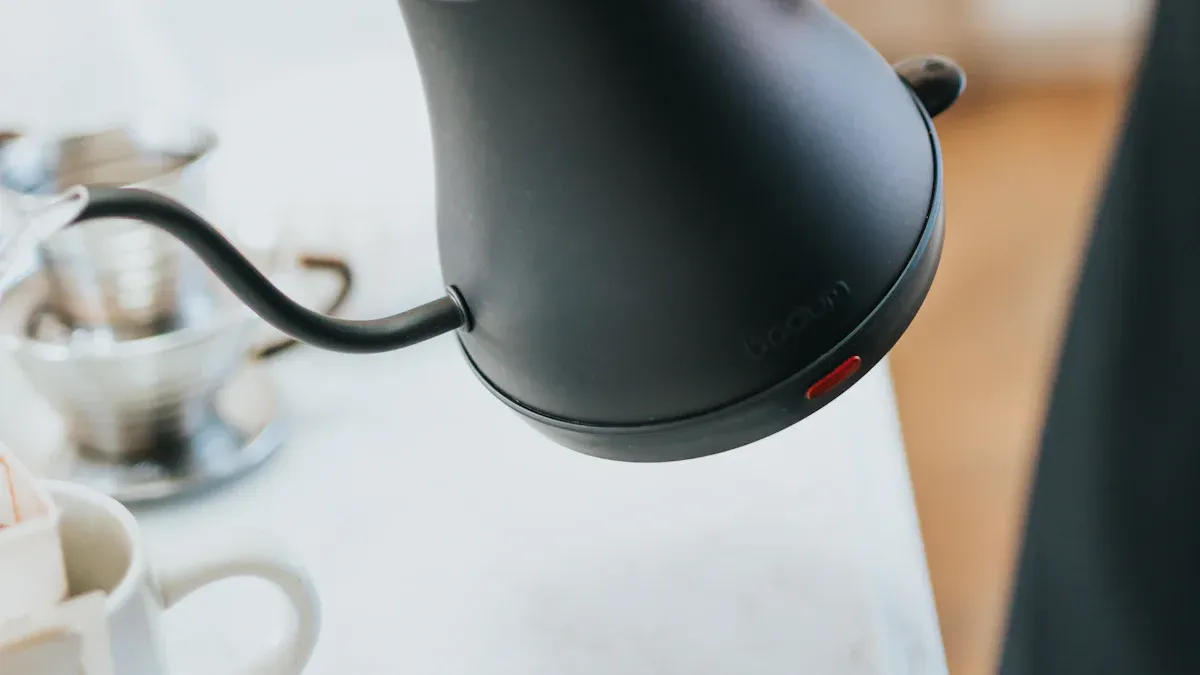
Pouring Control Differences
When you compare a gooseneck kettle to a regular kettle, you notice big differences in how you control the pour. The gooseneck kettle has a slender, curved spout. This design lets you pour water slowly and steadily. You can direct the flow exactly where you want it. This control helps you saturate coffee grounds evenly and avoid channeling, which leads to better extraction and flavor.
- The narrow spout of a gooseneck kettle keeps the flow rate steady, even if the kettle is full or nearly empty.
- You can use a circular motion to pour, making sure all the grounds get wet.
- The handle on a gooseneck kettle often feels more comfortable, so you can pour without straining your wrist.
Regular kettles have wide spouts. These make it hard to control the water flow. You might pour too fast or unevenly, which can cause some grounds to over-extract and others to under-extract. Many users and experts agree that a gooseneck kettle gives you the best results for pour-over coffee.
Temperature Feature Comparison
Temperature control also sets these kettles apart. Many gooseneck kettles come with built-in thermometers or digital temperature settings. You can heat water to the exact degree you need. This feature helps you brew coffee or tea at the right temperature every time.
| Feature | Gooseneck Kettle | Regular Kettle |
|---|---|---|
| Spout Design | Narrow, curved | Wide, straight |
| Pour Control | High precision | Low precision |
| Temperature Settings | Adjustable, digital | Usually not adjustable |
| Comfort | Ergonomic handle | Basic handle |
Regular kettles focus on boiling water quickly. They rarely offer precise temperature settings. If you want to control both the pour and the temperature, a gooseneck kettle gives you the tools you need for consistent, high-quality brewing.
A gooseneck electric kettle gives you unmatched control for perfect brewing. When you use precision pouring and set the right temperature, you unlock a perfect brew every time. Investing in a quality kettle transforms your brewing experience, making each cup rich and consistent. You taste the difference with every pour.
Tip: Practice slow, steady pours to enjoy the full flavor in every cup.
FAQ
How often should you descale your gooseneck electric kettle?
You should descale your kettle once a month. If you have hard water, clean it more often to prevent mineral buildup.
Tip: Use white vinegar or a commercial descaler for best results.
Can you use a gooseneck kettle for tea as well as coffee?
Yes, you can use your gooseneck kettle for both tea and coffee. The precise temperature control helps you brew any type of tea or coffee perfectly.
What is the best way to store your gooseneck kettle?
Store your kettle in a dry place. Make sure it is empty and unplugged. Wipe it down after each use to keep it clean and ready.
- Keep the cord wrapped neatly.
- Avoid storing near water sources.


